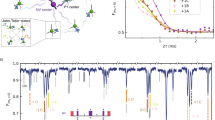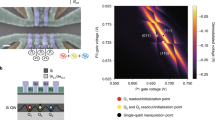Abstract
Quantum entanglement between spatially separated objects is one of the most intriguing phenomena in physics. The outcomes of independent measurements on entangled objects show correlations that cannot be explained by classical physics. As well as being of fundamental interest, entanglement is a unique resource for quantum information processing and communication. Entangled quantum bits (qubits) can be used to share private information or implement quantum logical gates1,2. Such capabilities are particularly useful when the entangled qubits are spatially separated3,4,5, providing the opportunity to create highly connected quantum networks6 or extend quantum cryptography to long distances7,8. Here we report entanglement of two electron spin qubits in diamond with a spatial separation of three metres. We establish this entanglement using a robust protocol based on creation of spin–photon entanglement at each location and a subsequent joint measurement of the photons. Detection of the photons heralds the projection of the spin qubits onto an entangled state. We verify the resulting non-local quantum correlations by performing single-shot readout9 on the qubits in different bases. The long-distance entanglement reported here can be combined with recently achieved initialization, readout and entanglement operations9,10,11,12,13 on local long-lived nuclear spin registers, paving the way for deterministic long-distance teleportation, quantum repeaters and extended quantum networks.
This is a preview of subscription content, access via your institution
Access options
Subscribe to this journal
Receive 51 print issues and online access
$199.00 per year
only $3.90 per issue
Buy this article
- Purchase on Springer Link
- Instant access to full article PDF
Prices may be subject to local taxes which are calculated during checkout




Similar content being viewed by others
References
Nielsen, M. A. & Chuang, I. L. Quantum Computation and Quantum Information (Cambridge Univ. Press, 2000)
Raussendorf, R. & Briegel, H. J. A. One-way quantum computer. Phys. Rev. Lett. 86, 5188–5191 (2001)
Moehring, D. L. et al. Entanglement of single-atom quantum bits at a distance. Nature 449, 68–71 (2007)
Ritter, S. et al. An elementary quantum network of single atoms in optical cavities. Nature 484, 195–200 (2012)
Hofmann, J. et al. Heralded entanglement between widely separated atoms. Science 337, 72–75 (2012)
Kimble, H. J. The quantum internet. Nature 453, 1023–1030 (2008)
Duan, L. M., Lukin, M. D., Cirac, J. I. & Zoller, P. Long-distance quantum communication with atomic ensembles and linear optics. Nature 414, 413–418 (2001)
Childress, L., Taylor, J. M., Sørensen, A. S. & Lukin, M. D. Fault-tolerant quantum communication based on solid-state photon emitters. Phys. Rev. Lett. 96, 070504 (2006)
Robledo, L. et al. High-fidelity projective read-out of a solid-state spin quantum register. Nature 477, 574–578 (2011)
Neumann, P. et al. Single-shot readout of a single nuclear spin. Science 329, 542–544 (2010)
Neumann, P. et al. Multipartite entanglement among single spins in diamond. Science 320, 1326–1329 (2008)
Maurer, P. C. et al. Room-temperature quantum bit memory exceeding one second. Science 336, 1283–1286 (2012)
Pfaff, W. et al. Demonstration of entanglement-by-measurement of solid-state qubits. Nature Phys. 9, 29–33 (2013)
Ladd, T. D. et al. Quantum computers. Nature 464, 45–53 (2010)
Togan, E. et al. Quantum entanglement between an optical photon and a solid-state spin qubit. Nature 466, 730–734 (2010)
Gao, W. B., Fallahi, P., Togan, E., Miguel-Sanchez, J. & Imamoglu, A. Observation of entanglement between a quantum dot spin and a single photon. Nature 491, 426–430 (2012)
De Greve, K. et al. Quantum-dot spin–photon entanglement via frequency downconversion to telecom wavelength. Nature 491, 421–425 (2012)
Bernien, H. et al. Two-photon quantum interference from separate nitrogen vacancy centers in diamond. Phys. Rev. Lett. 108, 043604 (2012)
Sipahigil, A. et al. Quantum interference of single photons from remote nitrogen-vacancy centers in diamond. Phys. Rev. Lett. 108, 143601 (2012)
Patel, R. B. et al. Two-photon interference of the emission from electrically tunable remote quantum dots. Nature Photon. 4, 632–635 (2010)
Flagg, E. B. et al. Interference of single photons from two separate semiconductor quantum dots. Phys. Rev. Lett. 104, 137401 (2010)
Fuchs, G. D., Dobrovitski, V. V., Toyli, D. M., Heremans, F. J. & Awschalom, D. D. Gigahertz dynamics of a strongly driven single quantum spin. Science 326, 1520–1522 (2009)
De Lange, G., Wang, Z. H., Ristè, D., Dobrovitski, V. V. & Hanson, R. Universal dynamical decoupling of a single solid-state spin from a spin bath. Science 330, 60–63 (2010)
van der Sar, T. et al. Decoherence-protected quantum gates for a hybrid solid-state spin register. Nature 484, 82–86 (2012)
Dolde, F. et al. Room-temperature entanglement between single defect spins in diamond. Nature Phys. 9, 139–143 (2013)
Barrett, S. D. & Kok, P. Efficient high-fidelity quantum computation using matter qubits and linear optics. Phys. Rev. A 71, 060310 (2005)
Bassett, L. C., Heremans, F. J., Yale, C. G., Buckley, B. B. & Awschalom, D. D. Electrical tuning of single nitrogen-vacancy center optical transitions enhanced by photoinduced fields. Phys. Rev. Lett. 107, 266403 (2011)
Robledo, L., Bernien, H., Van Weperen, I. & Hanson, R. Control and coherence of the optical transition of single nitrogen vacancy centers in diamond. Phys. Rev. Lett. 105, 177403 (2010)
Hong, C. K., Ou, Z. Y. & Mandel, L. Measurement of subpicosecond time intervals between two photons by interference. Phys. Rev. Lett. 59, 2044–2046 (1987)
Fu, K.-M. C. et al. Observation of the dynamic Jahn-Teller effect in the excited states of nitrogen-vacancy centers in diamond. Phys. Rev. Lett. 103, 256404 (2009)
Aharonovich, I., Greentree, A. D. & Prawer, S. Diamond photonics. Nature Photon. 5, 397–405 (2011)
Acknowledgements
We thank F. Jelezko, P. Kok, M. Lukin, J. Morton, E. Togan and L. Vandersypen for discussions and comments, and R. N. Schouten and M. J. Tiggelman for technical assistance. We acknowledge support from the Dutch Organization for Fundamental Research on Matter (FOM), the Netherlands Organization for Scientific Research (NWO), the DARPA QuASAR programme, the EU SOLID, DIAMANT and S3NANO programmes and the European Research Council through a Starting Grant.
Author information
Authors and Affiliations
Contributions
H.B., B.H., L.R, L.C. and R.H. designed the experiment. H.B., B.H., W.P., G.K. and M.S.B. performed the experiments. H.B., B.H., W.P., G.K., M.S.B., T.H.T. and R.H. analysed the results. H.B., M.M. and D.J.T. fabricated the devices. H.B., B.H., W.P., M.S.B., L.C. and R.H. wrote the manuscript. All authors discussed the results and commented on the manuscript.
Corresponding author
Ethics declarations
Competing interests
The authors declare no competing financial interests.
Supplementary information
Supplementary Information
This file contains Supplementary Text and Data, Supplementary Figures 1-9 and additional references. (PDF 451 kb)
Rights and permissions
About this article
Cite this article
Bernien, H., Hensen, B., Pfaff, W. et al. Heralded entanglement between solid-state qubits separated by three metres. Nature 497, 86–90 (2013). https://doi.org/10.1038/nature12016
Received:
Accepted:
Published:
Issue Date:
DOI: https://doi.org/10.1038/nature12016
This article is cited by
-
Correlated sensing with a solid-state quantum multisensor system for atomic-scale structural analysis
Nature Photonics (2024)
-
Non-classical microwave–optical photon pair generation with a chip-scale transducer
Nature Physics (2024)
-
Deterministic Bell state measurement with a single quantum memory
npj Quantum Information (2023)
-
Progress in quantum teleportation
Nature Reviews Physics (2023)
-
Advances in device-independent quantum key distribution
npj Quantum Information (2023)
Comments
By submitting a comment you agree to abide by our Terms and Community Guidelines. If you find something abusive or that does not comply with our terms or guidelines please flag it as inappropriate.



